|
|
King Abi Shemou Obelisk (National Museum of Beirut)
| Present Site: | National Museum of Beirut, Beirut, Lebanon N 33°52'42.5"(33.878464) E 35°30'53.3"(35.514818) |
| Pharaoh: | King Abi Shemou (Ancient Lebanon, corresponds to the Middle Kingdom of Egypt, Reigned 19 Century BC) |
| Measurement: | About 1.3 meters including the pedestal | Stone: | Granite |
About The Site:
After the Ottoman Empire was defeated in the World War I, Lebanon became a mandated territory of France (1920). Construction plan of the Museum was initiated by the French authorities in 1923, and the construction began in 1930 and completed in 1937. However the Museum didn't open since the France was occupied by Nazi Germany, and a mandated territory of France ended. Finally the Museum was opened in 1942 after the independence of Lebanon.
After World War II, Beirut, a capital of Lebanon, was known as "the Paris of the Middle East", and many tourists came here as one of leading resort areas in the World.
In 1975, the Museum was closed due to the civil war between Christians and Muslims, and received damages for 15 years. Repair work and the restoration of the Museum began in 1995, and the Museum finally resumed in modernized form, in October 1999. Thus, National Museum of Beirut has a long-time difficult history.
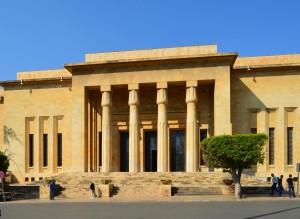
| |
|
National Museum of Beirut
|
The Museum, very stately building with an imitation of ancient Egyptian "Bud" style papyrus columns, is very impressive. The Museum has more than 100,000 collections, but only displayed 1,300 items.
How To Get There:
The railway service is not available in Lebanon due to the Civil war. Although Beirut is a large city (population: 1.8 million), but the public transportation is not well developed, and a few bus routes. So, we will use a taxi, but the system is that we negotiate the fare when getting on and pay when getting off. Therefore, we must be careful when catching the cruising taxi. It's better asking the hotel staff to tell the destination and negotiate the fare with the taxi driver when you are staying the hotel.
When choosing the hotel in Beirut, Hamra district of downtown would be convenient. After the end of civil war in 1991, reconstruction was well advanced and the scars of the civil war almost disappeared now. The Hamra district is convenient because there are many fast food shops and cafes that can communicate in English. We can see many English and French signboards (than local language) in Beirut, compared with other Middle East cities, and we can communicate in English with the general public.
The security in Beirut is generally good, but the National Museum from the Hamra district is apart about 2km. So, we should take a taxi instead of walking.
|
Museum's description (in English) INSCRIBED OBELISK WITH THE NAME OF ABI SHEMOU, KING OF BYBLOS Beloved of Herishef-Re Limestone Byblos (Temple of Obelisks) 19th c. B.C. |
About The Obelisk:
Little information on this obelisk was available through the internet, although there are many websites on the Temple of Obelisks in Byblos. I could only confirm that the obelisk that hieroglyphs are engraved in the Museum is on display until I visited here, but no further details were not available.
When I visited this Museum, I could soon find the obelisk which stands on the left side of exhibition room on the ground floor. The Museum's description was in Arabic, French and English, but the contents were very simple as shown in right side. According to this, the obelisk was erected by Abi Shemou, King of Byblos, at the Temple of Obelisks in 19 Century BC. The word of "Herishef" (or Heryshaf) is probably expressing the King Abi Shemou. He has a head of ram, and was identified with Ra and Osiris in Egyptian mythology. In other words, the hieroglyph says: the King, Beloved of Herishef-Re (Egyptian God), and I think this means this obelisk is in Egyptian style.
19 century BC when this obelisk was made corresponds to the time of the Middle Kingdom 12th dynasty of Ancient Egypt. This era is a century after Sesostris I (Senusert I) who erected the obelisk which currently remains in Heliopolis, and the era of Senusert II, Amenemhat III, and Amenemhat IV. In this time, Faiyum was developed, and many temples were built, and Egypt gained the prosperity again. An enormous amount of Lebanese cedar wood was probably carried away from Byblos. Also for the Phoenicians of Byblos, this time was the time that was revived the city and the harbor, which was destroyed by the invasion of the Amorites. This obelisk was made in such a historical background.
Unfortunately, hieroglyphs of the inscription is not confirmed due to a shallow engraving. In addition, the inscription is engraved on one side only, and other sides are still plain. In the Temple of Obelisks in Byblos, still 26 obelisks remain, but as far as I saw, there was no obelisk which keeps the inscription.
Notes For Pictures:
I visited here in May 2015. I did not feel particularly dangerous in Beirut city, but the risk level by Japan's Foreign Ministry was "please consider the travel to Lebanon" as Lebanon's neighboring country was Syria where the civil war continues, and Lebanon itself there is some controlled areas of Hezbollah, at that time. For this reason, I did see little tourist from Western and Asian countries in airport in Beirut and Beirut city. I have never seen the sightseeing bus in such as various World Heritage sites in Lebanon and Beirut city. Museum was virtually empty, and only a few people visited there.
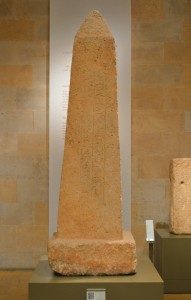 Flont |
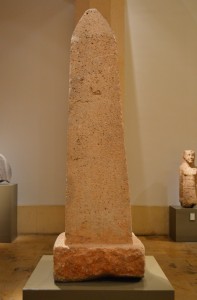 Left Side |
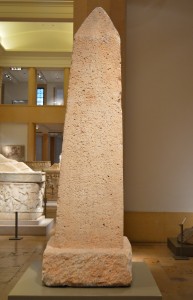 Right Side |
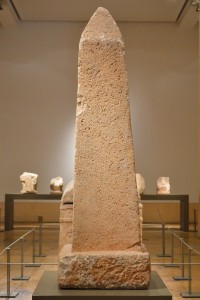 Back |
|||
May 5, 2015 by Hiroyuki Nagase (For high definition image, please click the picture) | ||||||
Copyright Hiroyuki Nagase nagase@obelisks.org and Shoji Okamoto okamoto@obelisks.org